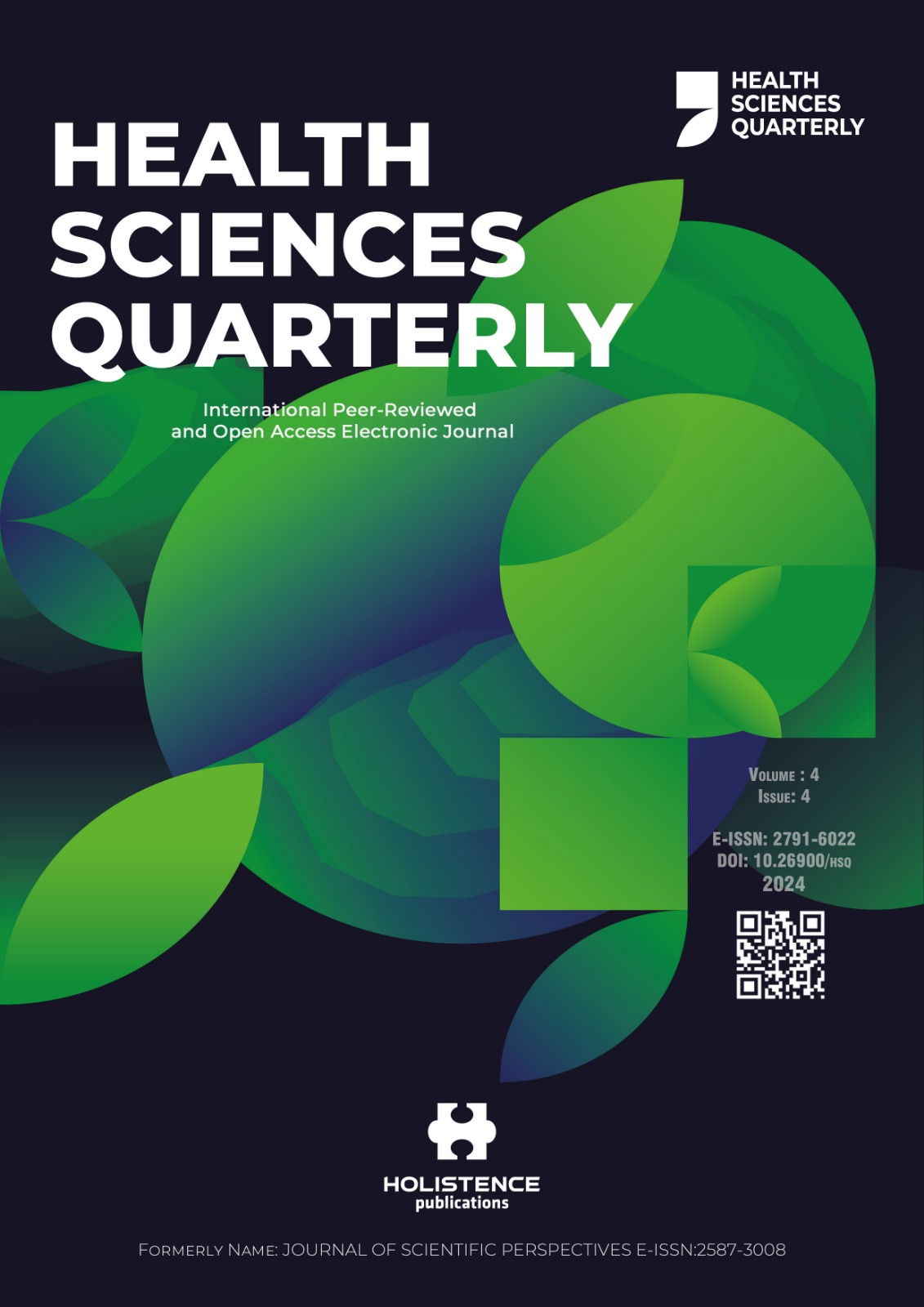The relationship between uropathogens and clinical characteristics of children with urinary tract infection
DOI:
https://doi.org/10.26900/hsq.2502Keywords:
Antibiotic resistance, children, urinary tract infection, uropathogenAbstract
Urinary tract infections (UTI) are common bacterial infections in children. This study aimed to examine the relationships between different microorganisms and both clinical and laboratory findings in pediatric patients with UTIs. We conducted a retrospective evaluation of children with UTI between 2019 and 2024. Patients were divided into four main groups as normal anatomy, vesicoureteral reflux (VUR), ureteropelvic junction obstruction (UPJO), and neurogenic bladder (NB). Information on clean intermittent catheterization (CIC) and prophylactic antibiotic use was recorded. Laboratory results were compared across these patient groups. The study included 266 patients, with a female predominance (female/male ratio: 7.33). NB was the most common urinary tract condition (43.3%), followed by VUR (10.9%) and UPJO (9%). Prophylactic antibiotics were used by 9% of the patients. Acute phase reactants in patients with CIC were significantly higher (p=0.023 for white blood cell (WBC) and p=0.002 for C-reactive protein (CRP) levels). They were also higher in patients with prophylactic antibiotics compared to those without (p=0.001 for both). The most frequently detected bacteria in urine cultures were E. coli (65%), followed by Klebsiella spp. (18.8%), Pseudomonas spp. (7.5%), and Proteus spp. (4.9%). Klebsiella spp., Enterococcus spp., and Morganella spp. were not isolated from patients receiving prophylaxis (p=0.022). Risk factors for UTIs need to be carefully assessed for every patient, and treatment should be customized according to clinical and laboratory results. Individual patient factors should guide drug selection, and treatment plans should account for potential resistance patterns.
Downloads
References
Korbel L, Howell M, Spencer JD. The clinical diagnosis and management of urinary tract infections in children and adolescents. Paediatr Int Child Health. 2017;37:273-9. doi: 10.1080/20469047.2017.1382046. DOI: https://doi.org/10.1080/20469047.2017.1382046
Millner R, Becknell B. Urinary tract infections. Pediatr Clin North Am. 2019;66:1-13. doi: 10.1016/j.pcl.2018.08.002. DOI: https://doi.org/10.1016/j.pcl.2018.08.002
Autore G, Bernardi L, La Scola C, Ghidini F, Marchetti F, Pasini A, et al. Management of pediatric urinary tract infections: A Delphi study. Antibiotics (Basel). 2022;11:1122. doi: 10.3390/antibiotics11081122. DOI: https://doi.org/10.3390/antibiotics11081122
Montini G, Tullus K, Hewitt I. Febrile urinary tract infections in children. N Engl J Med 2011;365:239-50. doi: 10.1056/NEJMra1007755. DOI: https://doi.org/10.1056/NEJMra1007755
Balighian E, Burke M. Urinary tract infections in children. Pediatr Rev. 2018;39:3-12. doi: 10.1542/pir.2017-0007. DOI: https://doi.org/10.1542/pir.2017-0007
Williams GJ, Macaskill P, Chan SF, Turner RM, Hodson E, Craig JC. Absolute and relative accuracy of rapid urine tests for urinary tract infection in children: A Meta-analysis. Lancet Infect Dis. 2010;10:240-50. doi: 10.1016/S1473-3099(10)70031-1. DOI: https://doi.org/10.1016/S1473-3099(10)70031-1
Strohmeier Y, Hodson EM, Willis NS, Webster AC, Craig JC. Antibiotics for acute pyelonephritis in children. Cochrane Database Syst Rev. 2014;CD003772. doi: 10.1002/14651858.CD003772.pub4. DOI: https://doi.org/10.1002/14651858.CD003772.pub4
Mattoo TK, Shaikh N, Nelson CP. Contemporary management of urinary tract infection in children. Pediatrics. 2021;147:e2020012138. doi: 10.1542/peds.2020-012138. DOI: https://doi.org/10.1542/peds.2020-012138
Montini G, Spencer JD, Hewitt IK. Urinary Tract Infections in Children. In: Emma F, Goldstein SL, Bagga A, Bates CM, Shroff R (eds). Pediatric Nephrology. 8th ed. Switzerland: Springer Nature, 2022: 1323-42. DOI: https://doi.org/10.1007/978-3-030-52719-8_49
Buettcher M, Trueck J, Niederer-Loher A, Heininger U, Agyeman P, Asner S, et al. Swiss Consensus recommendations on urinary tract infections in children. Eur J Pediatr. 2021;180:663-674. doi: 10.1007/s00431-020-03714-4. DOI: https://doi.org/10.1007/s00431-020-03714-4
Stein R, Dogan HS, Hoebeke P, Kočvara R, Nijman RJ, Radmayr C, et al. Urinary tract infections in children: EAU/ESPU guidelines. Eur Urol. 2015;67:546-58. doi: 10.1016/j.eururo.2014.11.007. DOI: https://doi.org/10.1016/j.eururo.2014.11.007
Su RR, Palta M, Lim A, Wald ER. Pyuria as a marker of urinary tract infection in neurogenic bladder: Is it reliable? Pediatr Infect Dis J. 2019;38:804-7. doi: 10.1097/INF.0000000000002370. DOI: https://doi.org/10.1097/INF.0000000000002370
Sherkatolabbasieh H, Firouzi M, Shafizadeh S. Evaluation of platelet count, erythrocyte sedimentation rate and C-Reactive protein levels in paediatric patients with inflammatory and infectious disease. New Microbes New Infect. 2020;37:100725. doi: 10.1016/j.nmni.2020.100725. DOI: https://doi.org/10.1016/j.nmni.2020.100725
Brandström P, Hansson S. Urinary tract infection in children. Pediatr Clin North Am. 2022;69:1099-114. doi: 10.1016/j.pcl.2022.07.003. DOI: https://doi.org/10.1016/j.pcl.2022.07.003
S Shaikh N, Shope TR, Hoberman A, Vigliotti A, Kurs-Lasky M, Martin JM. Association between uropathogen and pyuria. Pediatrics. 2016;138:e20160087. doi: 10.1542/peds.2016-0087. DOI: https://doi.org/10.1542/peds.2016-0087
Kenosi M, Whitla L, Khan N, Carty E, Coghlan D, Nadeem M. Interpretation of pyuria in children with urinary tract infection. Acta Paediatr. 2018;107:358. doi: 10.1111/apa.14133. DOI: https://doi.org/10.1111/apa.14133
Koçak M, Büyükkaragöz B, Çelebi Tayfur A, Çaltik A, Köksoy AY, Çizmeci Z, et al. Causative pathogens and antibiotic resistance in children hospitalized for urinary tract infection. Pediatr Int. 2016;58:467-71. doi: 10.1111/ped.12842. DOI: https://doi.org/10.1111/ped.12842
Yilmaz Y, Tekkanat Tazegun Z, Aydin E, Dulger M. Bacterial uropathogens causing urinary tract infection and their resistance patterns among children in Turkey. Iran Red Crescent Med J. 2016;18:e26610. doi: 10.5812/ircmj.26610. DOI: https://doi.org/10.5812/ircmj.26610
Erol B, Culpan M, Caskurlu H, Sari U, Cag Y, Vahaboglu H, et al. Changes in antimicrobial resistance and demographics of utis in pediatric patients in a single institution over a 6-year period. J Pediatr Urol. 2018;14:176.e1-176.e5. doi: 10.1016/j.jpurol.2017.12.002. DOI: https://doi.org/10.1016/j.jpurol.2017.12.002
Shaikh N, Liu H, Kurs-Lasky M, Forster CS. Biomarkers for febrile urinary tract infection in children. Pediatr Nephrol. 2022;37:171-7. doi: 10.1007/s00467-021-05173-x. DOI: https://doi.org/10.1007/s00467-021-05173-x
Foxman B. Urinary tract infection syndromes: Occurrence, recurrence, bacteriology, risk factors, and disease burden. Infect Dis Clin North Am. 2014;28:1-13. doi: 10.1016/j.idc.2013.09.003. DOI: https://doi.org/10.1016/j.idc.2013.09.003
Darogha SN, Azeez SH, Abdullah ZG. Evaluation of procalcitonin and interleukin-6 as a marker of bacterial urinary tract infection. Cell Mol Biol (Noisy-le-grand). 2022;67:203-13. doi: 10.14715/cmb/2021.67.4.23. DOI: https://doi.org/10.14715/cmb/2021.67.4.23
Subcommittee on Urinary Tract Infection, Steering Committee on Quality Improvement and Management, Roberts KB. Urinary Tract Infection: Clinical Practice Guideline for the Diagnosis and Management of the Initial UTI in Febrile Infants and Children 2 to 24 Months. Pediatrics. 2011;128:595-610. doi: 10.1542/peds.2011-1330. DOI: https://doi.org/10.1542/peds.2011-1330
Forster CS, Shaikh N, Hoberman A, Jackson E. Uropathogens and pyuria in children with neurogenic bladders. Pediatrics. 2018;141:e20173006. doi: 10.1542/peds.2017-3006. DOI: https://doi.org/10.1542/peds.2017-3006
Ünsal H, Kaman A, Tanır G. Relationship between urinalysis findings and responsible pathogens in children with urinary tract infections. J Pediatr Urol. 2019;15:606.e1-606.e6. doi: 10.1016/j.jpurol.2019.09.017. DOI: https://doi.org/10.1016/j.jpurol.2019.09.017
Esposito S, Biasucci G, Pasini A, Predieri B, Vergine G, Crisafi A, et al. Antibiotic resistance in paediatric febrile urinary tract infections. J Glob Antimicrob Resist. 2022;29:499-506. doi: 10.1016/j.jgar.2021.11.003. DOI: https://doi.org/10.1016/j.jgar.2021.11.003
Pouladfar G, Basiratnia M, Anvarinejad M, Abbasi P, Amirmoezi F, Zare S. The antibiotic susceptibility patterns of uropathogens among children with urinary tract infection in Shiraz. Medicine (Baltimore). 2017;96:e7834. doi: 10.1097/MD.0000000000007834. DOI: https://doi.org/10.1097/MD.0000000000007834
Downloads
Published
How to Cite
Issue
Section
License
Copyright (c) 2024 Holistence Publications

This work is licensed under a Creative Commons Attribution 4.0 International License.
When the article is accepted for publication in the HSQ authors transfer all copyright in the article to the Holistence Academy Ar-Ge Yazılım Yayıncılık Eğitim Danışmanlık ve Organizasyon Ticaret Ltd. Şti.The authors reserve all proprietary right other than copyright, such as patent rights.
Everyone who is listed as an author in this article should have made a substantial, direct, intellectual contribution to the work and should take public responsibility for it.
This paper contains works that have not previously published or not under consideration for publication in other journals.















